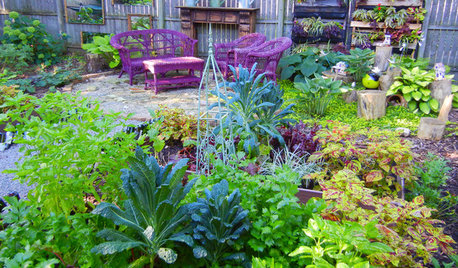What's growing on this begonia's soil?
jmmcd3
13 years ago
Related Stories

GARDENING GUIDESGrow a Beautiful Garden in Alkaline Soil
Got alkaline soil? Learn how to manage it and the many beautiful plants that will thrive in this ‘sweet’ soil
Full Story
HOUSEPLANTS10 Top Plants to Grow Indoors
Brighten a room and clean the air with a houseplant that cascades artfully, stretches toward the ceiling or looks great on a wall
Full Story
GARDENING GUIDES7 New Plants to Grow for Beautiful Foliage
Add color, structure and interest to your garden with these recently introduced plants that sport exceptional foliage
Full Story
GARDENING GUIDESShades of Vegetable Gardens: Growing Edibles in Less Sun
See how one gardener produces a veritable feast of vegetables and herbs under a canopy of shade
Full Story
GARDENING GUIDES10 Solutions for Soggy Soil
If a too-wet garden is raining on your parade, try these water-loving plants and other ideas for handling all of that H2O
Full Story
FARM YOUR YARDHow to Get Good Soil for Your Edible Garden
The nutrients in your soil feed the plants that feed you. Here are tips on getting it right — just in time for planting season
Full Story
GARDENING GUIDESGet the Dirt on Your Garden’s Soil
Understand how your soil supports your plants so you can ensure your garden’s success
Full Story
GARDENING GUIDESInvite Cellophane Bees to Your Garden by Providing Patches of Bare Soil
Look for cellophane bees (Colletes) pollinating flowering trees and shrubs in U.S. gardens this spring
Full Story
GARDENING GUIDESGardening Solutions for Heavy Clay Soils
What’s a gardener to do with soil that’s easily compacted and has poor drainage? Find out here
Full Story
GARDENING GUIDESHow to Stop Worrying and Start Loving Clay Soil
Clay has many more benefits than you might imagine
Full StoryMore Discussions








tapla (mid-Michigan, USDA z5b-6a)
jmmcd3Original Author
Related Professionals
Edmond Landscape Architects & Landscape Designers · Glen Ellyn Landscape Architects & Landscape Designers · Saint Charles Landscape Architects & Landscape Designers · Cockeysville Landscape Contractors · Coram Landscape Contractors · Dixon Landscape Contractors · Duarte Landscape Contractors · Gallatin Landscape Contractors · Glendale Heights Landscape Contractors · Harrisburg Landscape Contractors · Kaneohe Landscape Contractors · Muttontown Landscape Contractors · Pleasant Grove Landscape Contractors · Vancouver Landscape Contractors · Washington Interior Designers & Decoratorstapla (mid-Michigan, USDA z5b-6a)
pirate_girl
tapla (mid-Michigan, USDA z5b-6a)
vlmastra
tapla (mid-Michigan, USDA z5b-6a)
jmmcd3Original Author